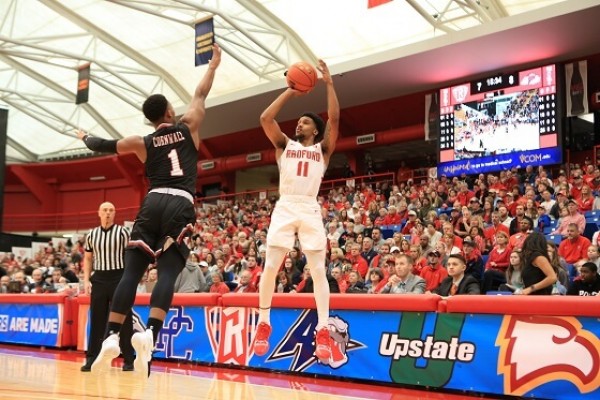Shooting the Threes
Coast To Coast : Shooting the Threes
Print

Big South Conference men’s basketball teams shot more 3-pointers than any other conference in the nation in 2018-19, part of a trend across basketball that started with the analytics-driven NBA and has trickled down to gyms and arenas everywhere.
Winthrop led the nation, sinking 12.4 3-pointers per game and joined Longwood and Campbell in the top 10 nationally in 3-point shots attempted. Each team easily exceeded the national average that climbed to a record 38.7 percent of all field goals attempted.
As Big South coaches identify and value shooters in recruiting, emphasize creating open shots in practice and give their players freedom to fire away in games, expect the long-range emphasis to continue in the 2019-20 season.
“We talk a lot about it as a staff,” said Longwood coach Griff Aldrich, whose team made a school-record 333 3-pointers last season, his first at the school. “It starts with recruiting, then you establish a culture where players are not looking over their shoulder. (Assistant) Marty McGillan jokes that in our program, you’re more likely to get yelled at for not taking an open 3-pointer than for taking what might be considered a bad one.”
In Big South games, players launched 45.1 percent of field goal attempts from beyond-the-arc -- the highest percentage among Division I’s 32 conferences, according to the advanced statistics website, KenPom.com.
Presbyterian set the Big South Conference Tournament-game record, drilling 21 3-pointers in a 106-point outburst against UNC Asheville. Winthrop made 10 or more 3-pointers in 23 of 30 games. Conference champion Gardner-Webb adopted a more balanced attack but was efficient on its attempts, leading the Big South in all games (39.7 pct.) and league battles (38.4).
In seven seasons under coach Pat Kelsey, the Winthrop Eagles have been an annual title contender, representing the Big South in the 2017 NCAA tournament and also at the forefront of the 3-point revolution. Last season 52.7 percent of their field goal attempts were 3-pointers, which was fifth in the nation.
Kelsey began focusing his team on the arc in 2014 after developing a relationship with Nick Nurse, then an assistant with the NBA’s Toronto Raptors who last season led the franchise to its first world championship as head coach.
Kelsey followed the analytics model and adopted the “shot spectrum” which ranks each shot on the floor based on per-shot efficiency. Free throws are first followed by attempts at the rim but 3-pointers are the next most valuable and Kelsey wants the Eagles to seek them and avoid taking mid-range jump shots from inside-the-arc and outside the lane.
Although the 3-point line is moving back more than 16 inches this season to the international line of 22 feet, 1 ¾ inches, Kelsey expects his team to “double down” and keep launching, relying on a roster loaded with players who were signed in part because of their ability to hit from long range.
Big South preseason favorite Radford made 285 3-pointers last season, which was the most in coach Mike Jones’ eight seasons but also eighth in 2018-19 among Big South members. With league leader Donald Hicks returning and preseason POY Carlik Jones and backcourt mate Travis Fields improving their stroke since last season, he expects the 3-pointer to play a larger role in the Highlanders’ attack this season.
“As a staff we’ve talked about it a great amount, actually,” Jones said. “ We have made a conscious effort to look to get more opportunities. We have good 3-point shooters. We have guys who can shoot ‘em, it’s a matter of us getting the best opportunity downcourt every time. If we can create open 3s we’ll take ‘em but we don’t want to take contested 3s.”
Building an environment where players understand the difference between a good shot and a bad one is a vital piece to fostering a proficient 3-point attack.
Campbell graduated Chris Clemons, the Big South’s career scoring leader and NCAA’s third all-time scorer, who made a conference-record 139 3-pointers a year ago. The squad also must replace starter Andrew Eudy who hit 31. Despite their departure, Camels coach Kevin McGeehan believes this roster is even deeper with capable shooters, based on percentages his staff charts during practice. He’s also unafraid to remind his players it’s the work they put in outside on their own that matters.
“Outside of practice we track who is shooting,” McGeehan said. “I may say ‘How many shots did you shoot last week?’ Or, “Do you know why that shot went in?” Try to encourage them to think the work equals the output.”
In transition, McGeehan wants the Camels to seek either a layup or wide open 3-pointer.
The Longwood coach Aldrich began embracing the 3-point shot when he played for Tony Shaver in a wide-open, up-tempo attack at Division III Hampden-Sydney. He refined his thoughts as an AAU coach in Houston and during his time as an assistant at UMBC, which used the 3-pointer to stun top-seeded Virginia in the 2018 NCAA tournament.
He believes the spread, 3-point oriented attack the Lancers employ is enjoyable for players and entertaining for fans. The longer shot won’t deter Longwood from letting it fly this season, however, as Aldrich expects his team to improve on the defensive end after it allowed opponents to make 320 3-pointers a year ago, nearly 10 per game.
“There are so many good shooters out there, you can even have a hand in their face but if they’re already in rhythm they can hit it anyway,” Aldrich said. “It’s a challenge, especially in a league like the Big South, which is a guard-dominated league. No. 1 you’re trying to stop penetration. At the same time you’re trying to recover to close out on shooters.”
Hampton coach Edward Joyner felt the pain of trying to stop the 3-pointer during his first season in the conference, often reminding his players an opponent was going to keep shooting from long range even if the shots weren’t falling at the moment. Hampton made adjustments to its defensive scheme as the season unfolded and was solid at limiting 3-pointers, holding Division I foes to 34.2 percent beyond-the-arc.
“It’s not the ones they miss that I’m worried about,” Joyner said with a laugh. “But the ones they make, three in a row in the last five minutes.”
UNC Asheville coach Mike Morrell steered the youngest team in the nation through the Big South last season. The Bulldogs were forced to play zone due to a lack of depth, which impaired their ability to stop opponents from shooting -- and hitting -- from deep. Big South teams made 35.8 percent against the Bulldogs. Morrell believes the longer line will make a greater impact based on conversations he’s had with coaches who took their teams on foreign tours over the summer.
Asheville made 32.3 percent last season and 42 percent of their field goal attempts were 3s.
“We didn’t take enough last year,” he said. “I’d like to see our attempts go up, but we played a much slower pace offensively.”
High Point was an outlier in Tubby Smith’s first season as coach. The Panthers scored just 25.1 percent of their points on 3-pointers (329th in the nation, 11th in Big South) and struggled to find the range when stepping outside to launch, hitting only 30.3 percent against DI competition.
Smith, 68, has won 613 games and a national championship in 28 seasons as a head coach and seen the number of 3-point attempts increase annually as the game has evolved.
“We probably didn’t shoot the 3-point shot enough last year,” Smith said. “And we didn’t make enough. We want to shoot more this season.”
| 3PA/ FGA | 3PFG pct. | Pct. pts 3Pters | |
| Winthrop | 52.7 (5th) | 37.3 | 44.4 (4th) |
| Longwood | 50.1 (6th) | 34.9 | 41.8 (11th) |
| Campbell | 48.3 (9th) | 34.3 | 38.0 (43rd) |
| Presbyterian | 47.6 (14th) | 38.1 | 41.8 (12th) |
| USC Upstate | 44.1 (45th) | 33.4 | 37.7 (48th) |
| Chas. Southern | 42.7 (81st) | 34.3 | 37.3 (52nd) |
| UNC Asheville | 42.1 (93rd) | 32.3 | 35.7 (82nd) |
| Radford | 38.2 (184th) | 37.9 | 34.9 (103rd) |
| Hampton | 38.1 (185th) | 34.6 | 31.0 (200th) |
| Gardner Webb | 37.6 (196th) | 39.7 | 31.1 (199th) |
| High Point | 33.6 (300th) | 31.3 | 25.1 (329th) |



